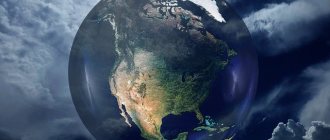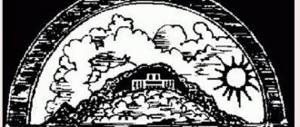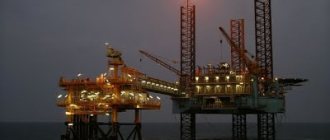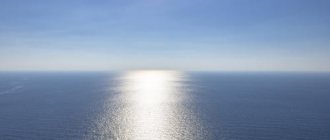Moon orbit
- Perigee (closest orbital point to Earth): 363,104 kilometers (varies between 356,400 – 370,400 kilometers).
- Apogee (the farthest point of the orbit from Earth): 405,696 kilometers (varies between 404,000 - 406,700 kilometers).
- The average speed of the Moon's orbit is about 1.023 kilometers per second.
- The Moon revolves around the Earth in an elliptical orbit with a period of 27.3 days, gradually moving away from it due to tidal acceleration by 38 millimeters per year, that is, its orbit is a slowly unwinding spiral.
Earth and Moon are double planets
The common center of mass around which the Earth and Moon rotate is located under the Earth's surface. The location of this point is unstable. It moves slowly towards the earth's surface.
This is due to the gradual increase in the distance between the Earth and its natural satellite. The emergence of the common center of mass into space above the earth's surface will mark the transformation of the Earth-Moon binary system into a double planet.
The transformation of a pair of cosmic bodies, consisting of the Earth and its satellite, into a double planet is predicted for the next few billion years.
Then the Moon, under the influence of tidal forces, will move away from the accompanying planet so much that the center of mass around which the objects rotate together will shift from under the earth's surface into the space between these astronomical bodies. The distance of the earth's satellite from the center of rotation occurs at a speed of 3 cm 7.4 mm per year.
It is still difficult to calculate the exact period of time that will be needed to transform the Earth-Moon pair into a double planet.
Physical characteristics of the Moon
- The surface temperature of the Moon ranges from −173 °C at night to +127 °C at the subsolar point. The temperature of rocks at a depth of 1 meter is constant and equal to −35 °C.
- The average radius of the Moon is 1737.1 kilometers, that is, approximately 0.273 the radius of the Earth.
- The surface area of the Moon is 3,793 x 107 square kilometers.
- The average density of the Moon is 3.3464 grams per cubic centimeter.
- The acceleration of gravity on the Moon is 1.62 meters per second squared (0.165 g).
- The mass of the Moon is 7.3477 x 1022 kilograms.
Presentation on the topic “Earth-Moon System” in astronomy
Slide No. 1
Slide text: Earth-Moon system
Slide No. 2
Slide text: Earth is the third planet from the Sun in the Solar System. Earth's mass is 5.974∙1024 kg, Average density is 5.515 g/cm3. The equatorial radius is 6,378 km. Polar radius is 6,356 km. The oblateness of the Earth at the poles is explained by rotation.
Slide No. 3
Slide text: The Earth's orbit is close to a circular orbit. Eccentricity e = 0.017. The radius of the Earth's orbit is 149.6 million km. The radius of the Earth's orbit is taken to be 1 astronomical unit. The orbital period is 365.256 Earth days or 1 year. The average orbital speed is 29.8 km/s.
Slide No. 4
Slide text: The second main rotation of the Earth is rotation around its axis. The change of seasons on Earth occurs due to three reasons: - the rotation of the Earth around the Sun; — inclination of the earth’s axis to the orbital plane; — maintaining the direction of the axis in space.
Slide No. 5
Slide text: Structure of the Earth
Slide No. 6
Slide text: Composition of the Earth's atmosphere by chemical elements Composition of the Earth by chemical elements
Slide No. 7
Slide text: The Earth's atmosphere consists of a number of layers - the troposphere, stratosphere, mesosphere, thermosphere, exosphere. The structure of the atmosphere A small amount of carbon dioxide in the earth's atmosphere creates a greenhouse effect. The earth is quite massive and holds an atmosphere near it.
Slide No. 8
Slide text: The Earth's atmosphere does not transmit hard short-wave radiation. Ozone is one of the most important gases that absorb ultraviolet rays.
Slide No. 9
Slide text: The Earth has a powerful magnetic field Radiation belts (Van Allen) and the Earth’s magnetosphere
Slide No. 10
Slide text: Sudden changes in the Earth's magnetic field are called magnetic storms. Magnetic storms often begin a day or two after chromospheric solar flares. They are caused by streams of particles moving at high speeds from the Sun. Charged particles, sliding along the Earth's magnetic lines of force, can penetrate the atmosphere. Colliding with atmospheric atoms, they cause a special glow called the aurora.
Slide No. 11
Slide text: Auroras are also visible from space Aurora from aboard the Space Shuttle
Slide No. 12
Slide text: The Moon is a satellite of the Earth. The radius of the Moon is 1738 km, i.e. approximately 4 times less than the radius of the Earth. The mass of the Moon is 7.35 * 1022 kg, i.e. approximately 81 times less than the mass of Earth
Slide No. 13
Slide text: The Moon influences the Earth, causing tides
Slide No. 14
Slide text: The visible side of the Moon The Moon always faces us with one side
Slide No. 15
Slide text: Moon phase The ratio of the area of the illuminated part of the visible disk of the Moon to its entire area is called the Moon phase. Numerically, the phase is equal to the ratio of the thickness of the illuminated part of the disk (d) to its diameter (D).
Slide No. 16
Slide text: At the new moon the phase is Φ = 0, at the first quarter Φ = 0.5, at the full moon Φ = 1.0, and at the last quarter again Φ = 0.5. There are four main phases of the moon: new moon, first quarter, full moon and last quarter.
Slide No. 17
Slide text: Conditions of visibility of the Moon depending on the phase The Moon quickly moves against the background of the starry sky from west to east by 13.5° per day, in the direction opposite to the daily rotation of the celestial sphere.
Slide No. 18
Slide text: The time interval between two successive identical phases of the Moon is called a synodic month; its duration is 29.53 days. The sidereal month, i.e. The time it takes the Moon to make one revolution around the Earth relative to the stars is 27.3 days. The Earth revolves around the Sun, so from one new moon to the next, the Moon rotates around the Earth not 360°, but somewhat more. Therefore, the synodic month is 2.2 days longer than the sidereal month.
Slide No. 19
Slide text: The occultation of the Sun by the Moon is called a solar eclipse. A solar eclipse is a very beautiful and rare phenomenon.
Slide No. 20
Slide text: A solar eclipse occurs if, at the moment of the full moon, the Moon crosses the plane of the ecliptic. Total solar eclipses can only be seen in those areas of the Earth through which the Moon's shadow passes. The diameter of the shadow does not exceed 270 km, so a total eclipse of the Sun is visible only on a small area of the earth's surface. Total solar eclipse on March 7, 1970. The lunar shadow is clearly visible on the Earth's surface.
Slide No. 21
Slide text: Annular solar eclipse If the disk of the Sun is completely covered by the disk of the Moon, then the eclipse is called total. At perigee, the Moon is closer to Earth by 21,000 km from the average distance, at apogee - further by 21,000 km. This changes the angular dimensions of the Moon. If the angular diameter of the Moon's disk (about 0.5°) turns out to be slightly smaller than the angular diameter of the Sun's disk (about 0.5°), then at the moment of the maximum phase of the eclipse a bright narrow ring remains visible from the Sun. This type of eclipse is called an annular eclipse.
Slide number 22
Slide text: Scheme of a total eclipse of the Sun. On both sides of the total phase strip, a partial eclipse of the Sun occurs. Although solar eclipses occur more often than lunar eclipses, in any given place on Earth solar eclipses are observed much less frequently than lunar eclipses.
Slide No. 23
Slide text: Scheme of the onset of a lunar eclipse Lunar eclipse During a total lunar eclipse, the Moon completely goes into the shadow of the Earth.
Slide No. 24
Slide text: Total solar eclipses can be seen only in those areas of the Earth through which the Moon's shadow passes. The diameter of the shadow does not exceed 270 km, so a total eclipse of the Sun is visible only on a small area of the earth's surface. Annular solar eclipse If the disk of the Sun is completely covered by the disk of the Moon, then the eclipse is called total. At perigee, the Moon is closer to Earth by 21,000 km from the average distance, at apogee - further by 21,000 km. This changes the angular dimensions of the Moon. Scheme of a total eclipse of the Sun Scheme of the onset of a lunar eclipse The reddish color of the moon's disk during lunar eclipses is due to the fact that red and orange rays pass through the atmosphere best. Lunar eclipse on July 16, 2000. View through a telescope.
Earth–Moon system
Of course, it is not entirely correct to talk about the movement of the Moon around the Earth. More precisely, both of these bodies revolve around their common center of mass, which lies below the surface of the Earth. Analysis of the Earth's vibrations showed that the mass of the Moon is 81 times less than the mass of the Earth.
The gravitational pull of the Moon causes the tides on Earth.
Tidal movements as a result of friction slow down the Earth's rotation, increasing the length of the Earth's day by 0.001 seconds per century.
Since the angular momentum of the Earth-Moon system is conserved, the slowing down of the Earth's rotation causes the Moon to slowly move away from the Earth. However, in the current era, the distance between the Earth and the Moon is decreasing by 2.5 cm per year due to the complex interaction of the Sun and planets with the Earth.
The Moon always faces the Earth with one side.
A detailed analysis of its gravitational field showed that the Moon is deformed in the direction of the Earth, but the distortion of its shape is too great for a modern tidal effect. This distortion is considered a “frozen tide,” left over from a time when the Moon was closer to the Earth and experienced stronger tidal influence from it than it is now. But this bulge may also represent heterogeneity in the internal structure of the Moon.
Moon illusion
Near the horizon, the Moon appears much larger in size than it does high in the sky. This is an optical illusion.
According to psychological experiments, the observer’s subconscious forms his own idea of the size of an object under the influence of the perception of the size of neighboring objects. The higher in the sky, the smaller the Moon is perceived, since it is in a large empty space. But closer to the horizon, its size is easily comparable to the distance from the Moon to the horizon, which unconsciously reinforces the impression of lunar size.
Physics lesson notes, grade 11. The structure of the solar system. Earth-Moon system.
| Item name | Physics |
| Class | 11 |
| UMK (textbook name, author, year of publication) | Physics. 11th grade: textbook. for general education Institutions: basic and profile. levels / G.Ya. Myakishev, B.B. Bukhovtsev, V.M. Chagurin; edited by IN AND. Nikolaeva, N.A. Parfentyeva. — 19th ed. – M.: Education, 2010. – 399 p., [4] l. ill. – (Classical course). – ISBN 978-5-09-022777-3. |
| Level of training (basic, advanced, specialized) | Base |
| Lesson topic | The structure of the solar system. Earth-Moon system. |
| Total number of hours allocated to study the topic | 5 |
| Place of the lesson in the lesson system | 2 |
| The purpose of the lesson | Recall the structure of the solar system and deepen knowledge about the concept of the Earth-Moon system. |
| Lesson Objectives | educational : form concepts about planets, asteroids, meteors, meteorites, comets; achieve an understanding of the structure of the solar system, the general properties of the terrestrial planets and giant planets, and the nature of the bodies of the solar system; study some of their characteristics; characterize the Moon and the Moon-Earth system, explain the phases of the moon; repeat and clarify concepts about eclipses; introduce and explain tidal phenomena. developing : development of logical thinking by systematizing facts, development of observation, formation of a worldview, development of cognitive activity, ability to draw conclusions, apply acquired knowledge to explain phenomena. educational : development of communication competencies, develop the ability to speak and listen to others, contribute to the formation of a worldview idea of cognition of phenomena and properties of the surrounding world. |
| Planned results | Be able to extract the necessary information from this material in order to explain and understand on this topic |
| Lesson technical support | multimedia projector, computer |
| Additional methodological and didactic support for the lesson (links to Internet resources are possible) | |
| Lesson content |
1. Organizational moment.
2. Motivation.
Like a flat, worn-out coin,
the planet rested on three pillars.
And they burned smart scientists in bonfires,
those who insisted “it’s not about the whales”
Naum Olev
Once the great thinker Socrates was asked what, in his opinion, was easiest in life. He replied that the easiest thing is to teach others, but the hardest thing is to know yourself. Is it easy to know yourself? We do this all our lives, and sometimes our efforts remain in vain. Is it easy to understand the world around us, the Universe???? ( No!
).
What science studies the Universe? ( Astronomy
).
In astronomy lessons we talk about understanding the Universe. Look at the slide and answer the questions: Appendix 1
| What could be common between such different objects? | They make up the solar system |
| Can we say that the solar system consists of homogeneous bodies? | No, bodies differ in size, mass, shape, chemical composition, and trajectories of movement. |
| What do you think we will study today? | The structure of the solar system. |
| What goals can we set for ourselves? | Find out the structure of the Solar system, its composition and characteristics of its components. |
3.Explanation of new material
.
Guys! Have you ever wondered what is hidden there, behind the “shell” of the sky? What is happening here on Earth, inside the physical bodies that surround us, and in the atoms of which they are made? And what is nature? But these questions have always worried a thinking person. A reflective person is always a doubting person. Only those who don’t want to know anything and don’t think about anything have no doubts. There is an old parable about a sage and a young man. The young man asked the sage: “You know much more than me: why, when answering questions, do you doubt much more often than I?” And then the sage drew two circles in the sand with a stick: a small one inside a large one. “Look,” he said to the young man, “inside the small circle is everything that you know, and inside the big circle is everything that I know. Isn’t it clear that the larger the circle, the longer the circumference that limits it, and therefore the greater the contact with the region of the unknown?” I would like to continue the parable with a well-known aphorism: You cannot teach a person for his whole life, he must be taught to learn for his whole life. Guys! Do you agree with this aphorism? Not only poets, but also physicists at times doubted the knowability of nature. However, such crises were inevitably overcome, ending each time with a new qualitative leap in the process of scientific knowledge. So let's find out what the solar system consists of .
Slide No. 3 (Conversation)
The solar system is a system of cosmic bodies, which, in addition to the central luminary - the Sun, includes eight planets, their satellites, many small planets, comets, cosmic dust and small meteoroids.
The radius is about two light years. In the middle of the 16th century, Polish astronomer Nicolaus Copernicus discovered the general structure of the solar system. He refuted the idea that the Earth is the center of the Universe and substantiated the movement of planets around the Sun. What name did this model of the solar system get? ( heliocentric).
Who discovered the laws of planetary motion in the 17th century? ( Kepler)
, and who formulated the law of universal attraction?
( Newton)
. But only after Galileo invented the telescope in 1609, it became possible to study the physical characteristics of the cosmic bodies that make up the solar system. Thus, Galileo, observing sunspots, first discovered the rotation of the Sun around its axis. In order to study the movement of bodies, we must first determine the characteristics that describe this movement. The most important orbital characteristics of the motion of cosmic bodies are the sidereal and synodic periods of revolution.
Sidereal period of revolution
- the period of time during which any celestial body-satellite makes a complete revolution around the main body relative to the stars.
Synodic period of revolution
(from the Greek conjunction) - the period of time between two successive conjunctions of the Moon or any planet in the Solar System with the Sun when observed from the Earth.
According to modern data, eight large spherical bodies called planets orbit the Sun. Along with the planets and their satellites, dwarf planets, thousands of small planets called asteroids, as well as comets and dust particles orbit the Sun. The planets revolve around the Sun in the same direction as the Sun around its axis, and are removed from the Sun in the following order:
Mercury (0.4 AU), Venus, Earth, Mars, the asteroid belt, Jupiter, Saturn, Uranus, Neptune (according to modern data, Pluto (40 AU) is classified as a dwarf planet), beyond the orbit of Neptune is the Kuiper belt, and beyond the Kuiper belt there is probably an Oort cloud.
But according to physical characteristics, they are combined into two groups, delimited in space by an asteroid belt (width 3 AU).
Terrestrial planets
. The planets that move inside the asteroid belt (Mercury, Venus, Earth and Mars) belong to the terrestrial group, as they have much in common.
All these planets are small in size and mass (the largest of them is Earth).
They have a solid surface, a relatively high average density, close to that of the Earth (5.5 g/cm3), and have atmospheres (except Mercury).
Terrestrial planets are composed of heavy chemical elements.
Giant planets
.
The planets moving behind the ring of asteroids form a group of giant planets, headed by Jupiter - the largest and most massive planet in the solar system. Its diameter is 11 times the diameter of the Earth and is 142,800 km. This group also includes Saturn, Uranus and Neptune. Slides 4-7
| Name planets | Equatorial diameter | Average distance from the Sun | Quantity satellites | Sidereal period | Average density | ||
| km | in Earth diameters | million km | A. e. | years | 1000 kg/m3 | ||
| Mercury | 4900 | 0,38 | 58 | 0,387 | — | 0,24 | 5,5 |
| Venus | 12100 | 0,95 | 108 | 0,723 | — | 0,61 | 5,2 |
| Earth | 12756 | 1,00 | 150 | 1,000 | 1 | 1,00 | 5,5 |
| Mars | 6800 | 0,53 | 228 | 1,524 | 2 | 1,88 | 3,9 |
| Jupiter | 142000 | 11,2 | 778 | 5,203 | 63 | 11,86 | 1,3 |
| Saturn | 120000 | 9,5 | 1426 | 9,539 | 62 | 29,46 | 0,7 |
| Uranus | 50000 | 3,9 | 2869 | 19,18 | 27 | 84,02 | 1,4 |
| Neptune | 50000 | 3,9 | 4496 | 30,06 | 13 | 164,8 | 1,6 |
| Pluto | 2800 | 0,2 | 5900 | 39,44 | 1 | 247,7 | 2,0 |
Slide 8
First, let's pay attention to the location of the planets from the Sun, the only star in the solar system: Mercury, Venus, Earth, Mars, Jupiter, Saturn, Uranus, Neptune, Pluto. To compare the sizes of the planets, let's try to introduce a scale. Do you have any suggestions?
As a result of the discussion, we come to the conclusion: let’s draw a circle in a cell of a notebook sheet - this will be the Earth, and then using the second column of the table, we’ll draw all the other planets on the selected scale.. So, about half a cell in diameter - Mercury and Mars, one cell in diameter – Venus, 11 cells in diameter – Jupiter, 9.5 cells – Saturn, 4 cells each – Uranus and Neptune. Pluto will be drawn almost as a dot. Let's analyze it.
Your suggestions? After discussion, we conclude: Mercury, Venus, Earth, and Mars are very similar in size. These are terrestrial planets.
Much larger in size are Jupiter, Saturn, Uranus and Neptune. These are giant planets. It should be noted that the largest planet in the solar system is Jupiter. Now Pluto is not classified as a terrestrial planet or as a giant planet. Astronomers propose to classify this planet as an asteroid. It should be noted that if we had to draw the Sun on our scale, we would have to draw a circle of 109 cells. That's how many times the Sun is larger in diameter than the Earth!
Comparing the number of satellites and the average density of planets, we will give a general description of these groups of planets. After discussion we come to a conclusion. Terrestrial planets are small in size and mass, have a high average density, they have a solid surface and consist of heavy chemical elements, have atmospheres other than Mercury, have a small number of natural satellites, and rotate slowly around their own axis compared to giant planets.
Giant planets have significant sizes, low average density (they consist of gases and therefore do not have a solid surface), rapid rotation around their own axis, extended atmospheres, and a huge number of satellites. Giant planets are surrounded by rings consisting of small solid particles.
Now let's analyze the location of the planets. Let's introduce the scale. What proposals will there be? Let 1 a.u. will be equal to 1 cm or 2 notebook cells, and we begin to mark the location of the planets on the table from the very left edge of the notebook. We place Mercury 4 mm from the Sun, Venus 7 mm from the Sun, Earth 1 cm, etc. All planets whose trajectory is inside the Earth’s are called internal, and those outside are called external. We conclude which planets are internal and which are external?
To the internal ones - Mercury, Venus, to the external ones - Mars, Jupiter, Saturn, Uranus, Neptune.
— Student’s message about the Earth’s satellite, the Moon.
Main conclusions:
– Moon
- This is the only natural satellite of our planet - Earth.
– Star
is a massive ball of gas that emits light and heat as a result of thermonuclear fusion reactions occurring in its depths.
– Planet
is a celestial body orbiting a star (or its remnant) that is massive enough to become rounded under the influence of its own gravity, but not massive enough to initiate a thermonuclear reaction.
– Satellite
is any celestial body rotating in a certain orbit around another object (for example, a planet).
– Synodic period of the Moon
is the period of time between two successive new moons.
The sidereal period of the Moon
is the period of its revolution around the Earth.
– Solar and lunar eclipses, as well as tides
and
low tides
.
4. Lesson summary.
And so, astronomy is the science of the Universe, studying the movement, structure, origin and development of celestial bodies and their systems. Indeed, nature has many secrets and mysteries; it reveals them reluctantly, so each successive solution is an important step for humanity on the path to understanding the world.
5. Primary consolidation
: Make a diagram of the “Solar System” (Slide 16). Final test Appendix 1 and peer review ANSWERS ON SLIDE No. 15
6. Homework.
§115 - 119, using the Internet, prepare messages about the stars.
This concludes our lesson. Thank you for the lesson. Goodbye.
Downloaded from www.znanio.ru
Changes in the apparent shape of the Moon
Since the Moon is a spherical body, when it is illuminated from the side, a “sickle” appears. The illuminated side of the moon always points towards the Sun, even if it is hidden behind the horizon.
The duration of the complete change of phases of the Moon (the so-called synodic month) is variable due to the ellipticity of the lunar orbit. The average synodic month is 29 days 12 hours 44 minutes 2.82 seconds.
In phases of the Moon close to the new moon (at the beginning of the first quarter and at the end of the last quarter), with a very narrow crescent, the unlit part forms the so-called. ashen light of the Moon - the visible glow of a surface not illuminated by direct sunlight of a characteristic ashen color.
The moon goes through the following phases of illumination:
- new moon - a state when the moon is not visible.
- new moon - the first appearance of the Moon in the sky after the new moon in the form of a narrow crescent.
- the first quarter is the state when half of the Moon is illuminated.
- waxing moon
- full moon - a state when the entire moon is illuminated.
- waning moon
- the last quarter is the state when half of the Moon is illuminated again.
- old moon
Usually there is one full moon per calendar month, but since the phases of the moon change a little faster than 12 times a year, sometimes there are a second full moon in a month, called a blue moon.
Mnemonic rule for determining the phases of the moon
To distinguish the first quarter from the last, an observer located in the northern hemisphere can use the following mnemonic rules. If the lunar crescent in the sky looks like the letter “ C ,” then this is the “Aging” or “Descending” moon, that is, this is the last quarter. If it is turned in the opposite direction, then by mentally placing a wand on it, you can get the letter “R” - the moon is “Waxing”, that is, this is the first quarter.
The waxing month is usually observed in the evening, and the aging month in the morning.
It should be noted that near the equator the month is always visible “lying on its side”, and this method is not suitable for determining the phase.
In the southern hemisphere, the orientation of the crescent in the corresponding phases is the opposite: the waxing month (from new moon to full moon) looks like the letter “C”, and the waning month (from full moon to new moon) looks like the letter “D” without a stick.
If, in the direction of the moon's movement, the leading edge is illuminated, the moon is waxing; if the edge is shaded, the moon is waning.
Definition of a double planet
This term is commonly used among astronomers to denote a binary system of two cosmic bodies, each of which has sufficient mass to exert a gravitational effect. The gravity of astronomical bodies must exceed the gravitational effect of the star, which is the center of their rotation.
Another requirement is that both parts of such a binary system must rotate around a common center of mass located above their surfaces.
This conditional point, which is the common center of mass, is also called the barycenter.
The common center of mass around which the Earth and Moon rotate is located under the Earth's surface. However, despite this, the European Astronomical Society put forward a proposal to consider the system consisting of the Earth and its satellite as a binary system.
This initiative is due to the fact that the Moon differs sharply from other satellites in the solar system:
- It is one of the largest and heaviest satellites in the Solar System in relation to its central cosmic body. The sizes of cosmic bodies accompanying other planets of the solar system are 1/10 of the diameter of the central celestial bodies, or even less. In turn, the diameter of the Moon is a quarter of the diameter of the space object around which this satellite rotates.
- The mass of the Moon is also unusual for a planetary satellite. It is 1/81 of the mass of the central cosmic body, while the satellites of other planets of the Solar System are tens of thousands of times lighter than their centers of rotation.
Another feature that is cited as an argument in favor of the Earth-Moon double planet is the proximity of these space objects. Researchers associate the following remarkable fact with this feature: the Moon’s path around the Sun practically repeats the Earth’s, differing only slightly from it.
Moon satellite. CREDIT: xn--80apbncz.
For clarity, the following example is given: for a conventional observer placed on the surface of the Sun, the trajectory of the earth’s satellite would appear to be a somewhat wavy line that would almost coincide with the earth’s orbit.
All these arguments seem quite convincing to supporters of the theory of a binary planet “Earth-Moon”, despite a number of differences between the two celestial bodies:
- A wide range of temperatures on the lunar surface: overnight it cools down to -173°C, while during the day it heats up to 130°C. In turn, terrestrial temperature fluctuations are much less pronounced.
- The earth's core has much more pronounced gravity.
- On the earth's satellite, unlike the Earth, there is no water. The lunar seas are valleys filled with petrified lava; on top they are covered with a layer of rocks once thrown out by volcanoes. Their craters are still visible: they reach 200 km in diameter, surrounded by steep slopes rising in the form of a rampart.
Another pair of astronomical objects in the solar system is in a similar relationship: the Sun and Jupiter. However, since Jupiter is not a star, this pair cannot be classified as a binary planet or double star.
Difference between Moon and Earth
Although there are about 400 thousand kilometers between the Earth and the Moon, they are closely connected and capable of influencing each other. The moon interacts with all earthly nature, activating, for example, the ebb and flow of the sea. However, these two celestial bodies have quite a lot of differences from each other.
Comparison
The Earth is 81 times larger than the Moon in mass. The radius of the Moon is approximately three and a half times smaller than the radius of the Earth.
Comparison of the sizes of the Moon, Earth and Mars
The earth is surrounded by the geosphere - a gas shell with various impurities. There is practically no atmosphere on the Moon, no oxygen, no wind. Therefore, during the day, the surface of the Moon heats up to 120°C from the scorching Sun, and at night it can cool down to –160°C.
It is light on Earth during the day and dark at night. On the Moon, even during the day, the sky is always black and cloudless: with the bright Sun, the sky is strewn with stars. From Earth, the sky appears blue: the air gives it this color. The sun's rays are scattered, and the stars are not visible during the day.
The Earth reflects sunlight about 50 times more strongly than the Moon.
Most of the Earth is occupied by seas and oceans, the smaller part is occupied by continents and islands. The surface of the Moon consists of mountainous terrain and lunar maria (huge craters with solidified lava).
The lunar mountains were most likely formed after the collision of huge meteorites with the surface, while the mountains on Earth are the result of tectonic processes.
The moon is covered with a mixture of rocky debris and fine dust, the so-called regolith , up to several tens of meters thick.
On the Moon, unlike the Earth, there is no volcanic activity and practically no water (except for small reserves of ice). The Earth's surface is constantly exposed to water and wind, the surface of the Moon does not erode or weather.
The Moon's magnetic field is very weak, and the force of gravity is six times less than that of the Earth.
The chemical composition of both the Earth and the Moon is different. For example, the Earth contains a fairly large amount of iron, while the Moon has practically none.
conclusions
- The Earth is 81 times heavier than the Moon.
- The radius of the Moon is on average 3.5 times smaller than the radius of the Earth.
- On Earth there is an atmosphere, oxygen, water, and therefore organic life. There is none of this on the Moon.
- During the day it is light on Earth, you can see the blue sky, but at night it is dark. On the Moon the sky is always black and cloudless.
- The Earth reflects sunlight about 50 times more strongly than the Moon.
- The surface of the Earth is occupied by continents, oceans, seas and islands. Mountains and lunar seas (giant craters) are formed on the surface of the Moon.
- On the Moon, gravity is six times less than on Earth.
- The Earth has a magnetic (geomagnetic) field, while the Moon has almost none
- The chemical composition of the two astronomical objects is different.
Video
The Moon is a natural satellite of the Earth - summary - Astronomy, Abstracts from Astronomy
1
Japan. The first soft landing on the Moon was made in February 1966 by the Soviet lunar station "Luna-9", as if the petals of a flower unfurled the station's antennas, and it began its first television report from the surface of the Moon. “Luna 92 put an end to the hypothesis that the lunar seas were covered with a layer of dust. Americans F. Borman, J. Lovell and W. Anders celebrated Christmas 1969. in the Apollo 8 spacecraft on the Earth-Moon-Earth route. This was the first manned flyby of the Moon. The flight of the first American expedition to land on the Moon on the Apollo 11 spacecraft began on the sunny morning of July 16, 1969. Contact with the lunar surface occurred on July 20. Crew commander N. Armstrong slowly descended the shaky stairs, like a bather testing the cold water, and stood on the Moon with great caution. “One small step for a man, and such a huge leap for all mankind,” were the first words he said on the Moon. Soon E. Aldrin joined him. The traces of their shoes will remain in the conditions of the Moon for millions of years. The third crew member, M. Collins, patiently waited for his comrades in lunar orbit, drawing news about them from stories from Earth. From July 1969 to December 1972 In the United States, 6 successful expeditions to the Moon were carried out, during which 12 astronauts visited the surface, spending there in pairs for a total of 12 and a half days. During the Apollo program, 12 more astronauts worked in cislunar space. Cosmonauts J. Young, Y. Cernan and J. Lovell flew to the Moon 2 times, but the last of them, whose name is one of the lunar craters, never reached the surface. J. Lovell was the commander of the Apollo 13 crew, whose landing on the Moon was canceled due to an accident. Professional geologist Schmitt took part in the final American expeditions on the Apollo 17 spacecraft. In just 6 expeditions, the Americans delivered about 400 kg to Earth. Samples of lunar rocks. In the final three expeditions to the Moon, American astronauts used an electric vehicle designed specifically for movement in lunar off-road conditions, which dramatically expanded the capabilities of field surveys of the area. The car could reach speeds of up to 14 km/h. Geologist Schmitt and Yu. Cernan drove about 35 km on the Moon in this car. The Saturn 5 launch vehicle, which carried US astronauts to the Moon, is still the largest rocket in the world. Its height reaches a 40-story building, and when launched, it burns 15 tons of fuel every second. It is unlikely that even larger rockets will ever be designed, since after the flights to the Moon it became clear that even for the existence of the giant Saturn 5 there are no more reasonable tasks. Production of these missiles was discontinued. It is estimated that all promising tasks
docsity.com







